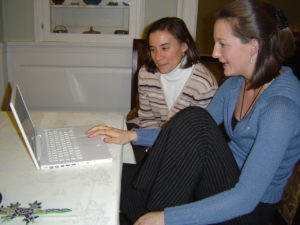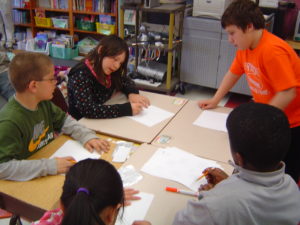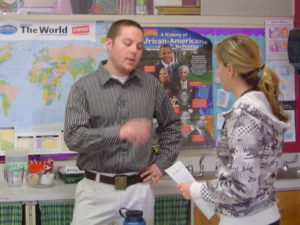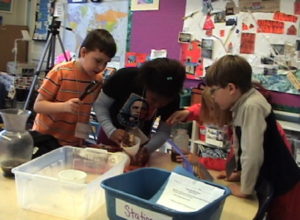
Chairing the Department of Professional Education and Curriculum Development
In the late eighties, I served a total of five and a half years as Chair of my Department, first in “Acting” capacity and later as a full-time. Taking on the role was kind of a “draft Charlie” movement. I was the only applicant for the position when I decided to move out of the acting role. After four years as Chair, the stress of the job and my reaction to the created health issues for me. I faced what I suppose are typical challenges for a middle level leader with lots of responsibility and little real authority to make things happen: personnel transitions in the Dean’s office, impending faculty harassment suits, anger from prima dona colleagues, fighting for more a equitable distribution of resources across graduate and undergraduate programs, advancing program organization, centralizing leadership, advocacy for collaborative professional development school arrangements, keeping up with the flood of daily demands. Taken as a whole, these initiatives interacted poorly with the workaholic/conflict-avoidance/take-it-on-myself tendencies of my ACOA existence. There was no joy in Mudville for me in this job. I had great visions of the forest, could even inspire colleagues with those visions, and I was totally lost in the trees. After four years I tendered my resignation and transitioned to a faculty position.
The late eighties and early nineties were increasingly active years when it came to educational policy making. I intentionally became more active statewide on two levels: teacher education and professional standards.
In the early and mid-eighties, there was virtually no collaboration across Vermont’s teacher education community except as we reacted from our separate rabbit holes to state-wide initiatives of a series of Commissioners. I worked hard to re-invigorate the Vermont Council of Teacher Educators as an independent advocacy group that could represent the cause of teacher education in state-wide legislative and department-based discussions. The high point of my work here was working hand in hand with Don McCafferty and Dick Dillon to pull off a national conference on the use of Vermont’s portfolio assessment in teacher education. Lee Shulman keynoted our conference attended by representatives from all over the US. I felt a good deal of pride that Vermont’s particular way of enabling students to portray what they knew and were able to do and do it in a way that was highly personalized received national exposure and recognition. That event was precipitated by the creation of new state-wide standards for Vermont educators in which I also played a significant hand.
Framing state-wide standards for teacher education
I was asked to serve on the first Vermont Standards Board for Professional Educators (VSBPE). Our first task was to create a set of standards for Teacher Education and I ended up drafting the version that became statute. The inaugural membership of the board was a progressive thinking group of educators, only two of which represented higher education. As a group, we set in place a framework for thinking about the profession that remains in place today. Every Vermont teacher and administrator creates and carries out a plan for professional renewal that continues to address the standards we wrote a decade and a half ago: Learning, Professional Knowledge, Colleagueship, Advocacy, and Accountability. The accountability standard grounds the assessment of personal competence, what you know and are able to do as an aspiring or in-place teacher or administrator in an individualized, professional portfolio. It was the accountability standard that provoked the work we showcased at the national conference on portfolio assessment in teacher education. It was incredibly gratifying to me to have this window of opportunity where I could both participate in statewide policy-making, and help develop a response to the new policies in my more immediate professional community by continuing to push forward a view of assessment that was particular to the individual.
Watching cognitive revisioning before my very eyes
I loved working with our Senior undergraduates as they went about the work of assembling their portfolios. We were totally in “invention-mode” as my colleagues and I created a support process for them in portfolio creation. In the early days, before more defined required state and national criteria were established, colleagues and I would meet with our students over the course of a semester and lead them through what I thought was a process of portfolio construction essentially grounded in the cognitive framework of concept formation. We asked them to “document everything” they did with students during their final two years in the program. Of course they didn’t document “everything” as they moved through the program but when we arrived at the point where we worked with them to design the organization of the portfolio, each student brought files and files of papers, pictures, assignments, journal entries, video tape to the table. Their task was two-fold: first, out of their mass of documents, they had to select several groupings (piles, literally) of documents that they considered “definitional’ in terms of what was important to them as a teacher; second, across this mass of documents, they had to make sure they could show how they met eleven operational criteria that defined the purpose and mission of our teacher education program.
It was fascinating to watch student thinking move from a bunch of loosely held ideas about who they were as a teacher to affirm with much more certainty and coherence what was important to them and what they were capable of doing with children in a classroom. This was the concept formation part of the process. By having to sift through the layers and layers of what they knew and what they had done, they were in effect creating a view of themselves that was both comprehensive in its coverage and personally unique in its descriptive qualities. In short, once this process was done, each student could pretty much tell what  they stood for as a teacher as well as what they did not stand for. From a Piagetian perspective, the entire process of portfolio construction was replete with a good deal of cognitive dissonance for our students. Facing those piles of documents often brought frustration in the very real need to bring order to the collection of documents from four years of study. As students worked through the piles, as they began to group the documents into grouping s that portrayed methods, events, strategies that were particularly appealing to them, there came a much finer and discrete ability to conceptualize teaching in general and their teaching abilities in particular. Frankly, I thought the process was genius. The inductive process looked something like this.
they stood for as a teacher as well as what they did not stand for. From a Piagetian perspective, the entire process of portfolio construction was replete with a good deal of cognitive dissonance for our students. Facing those piles of documents often brought frustration in the very real need to bring order to the collection of documents from four years of study. As students worked through the piles, as they began to group the documents into grouping s that portrayed methods, events, strategies that were particularly appealing to them, there came a much finer and discrete ability to conceptualize teaching in general and their teaching abilities in particular. Frankly, I thought the process was genius. The inductive process looked something like this.
After collecting artifacts from their teaching over three years in the program, students:
- Bring in boxes and files of photos, lesson plans, papers for courses, projects for courses, work they’d done with students, etc… .
- Sort “stuff” into piles and label the piles that contain documents that portray work they really do well and like to do, for example
Pile Label
Working with kids in small groups Groupwork
Using manipulatives Hands-on learning
Using meetings to solve class problems Democratic Problem Solving
Role playing, puppets, writer’s chair Multiple Strength Curriculum
- Begin to consider an overall theme for their Portfolio: for the piles and labels just suggested, maybe the theme is “Turned On Students, Turned On Learning,” advancing the idea that light bulbs come on for kids when the learning is personalized, real, identity producing, and fun!
- Choose three or four documents from each pile and draft a caption for each that
- tells what the document is, when and where it was produced;
- what the document shows;
- names what their students are learning; and
- describes the meaning of the event including how it connects to the subtheme
- Fine tune the theme if necessary
- Cross reference the required Program Principles to individual documents, adding documents as appendices if principles are not fully exemplified in documents already chosen
This is me as a teacher – what I know and what I do
This process of construction literally allows a portfolio to be built from actual documentation of what the student already knows and is able to do. What the process achieves is a kind of higher level reasoning (analysis, synthesis, and evaluative thinking) about who they really are as a teacher (Bloom, 1958). The process frees the student to cognitively consolidate their knowledge based in  several critically important ways. First of all, the bits of knowledge that have constituted the student’s education to this point across many courses and four years of college are considered as part of one fabric or cloth…their education. Second, assignments that illuminate a given characteristic (groupwork, for example) are collected from several different courses. This in itself consolidates separate and often disparate clusters of knowledge into common categories achieving important integrations of knowledge structures. Third, the consolidation allows the students to create a “whole” idea of a program that to date had been a fractured, sequential experience taught by different faculty who
several critically important ways. First of all, the bits of knowledge that have constituted the student’s education to this point across many courses and four years of college are considered as part of one fabric or cloth…their education. Second, assignments that illuminate a given characteristic (groupwork, for example) are collected from several different courses. This in itself consolidates separate and often disparate clusters of knowledge into common categories achieving important integrations of knowledge structures. Third, the consolidation allows the students to create a “whole” idea of a program that to date had been a fractured, sequential experience taught by different faculty who may from time to time present passionately held, conflicting information to the student. In the end, the student decides what is most important to them. Because of this process, in a few weeks, students become surprisingly articulate in their answers to the question, “What kind of teacher are you?”
may from time to time present passionately held, conflicting information to the student. In the end, the student decides what is most important to them. Because of this process, in a few weeks, students become surprisingly articulate in their answers to the question, “What kind of teacher are you?”
Statewide Workshop Giver (and film maker): The VISMT Experience
The best years of building these portfolios were the early years. The students had to respond to three masters, essentially; their own inductively inspired categories of description, the set of eleven program criteria, and four criteria that guided the construction of the portfolio itself: coherence, documentation, readability, and meeting requirements. In the past decade, accountability has become increasingly defined and even shrill, and additional criteria represented by NCATE demands, new statewide demands, and more refined programmatic demands have resulted in portfolios that are essentially constructed now to meet the externally imposed requirements of professional organization external to Vermont. For me, this has create significant losses for our students. Our profession is way out of whack (balance) with regard to accountability initiatives. A student’s individual decision making of meritorious practice for themselves has been sacrificed and become all but a whisper in the process. As Rebecca said to me this past semester, “I didn’t give much thought to myself when I put this portfolio together. I just put my pictures in the correct piles, wrote them up, made the binder and handed it in. I knew if it wasn’t right, I’d get a chance to correct it. All those requirements are pretty clear once you get the hang of it.” And she was right. I read her portfolio and judged it incomplete. I gave her feedback, she addressed my concerns, she was approved. Did she learn much from the process? Not really. Rebecca clearly saw the process as hoops to go through, assembling documents for someone else’s needs, not as a refining filter for her own edification of what the program had meant to her. For the most part, our students now re-construct their accomplishments so they might be seen as others would have them be, not as they themselves would wish to be. Reminds me of the title of an old Canadian Film Board production of the late 1960s, “What they want to produce, not what we want to become.” Our candidate’s loss of personal depth in the self-definition process of who they are as teachers is a tragic loss for teacher education. The portfolio has become another ritual to be carried out, full of sound and fury, signifying little.
I further witnessed the steady process wherein standards became standardization in the towns and villages of Vermont when I became the first Teacher Associate from higher education in Vermont’s statewide systemic grant known as VISMT (Vermont Institute for Science, Mathematics, and Technology). This was my third sabbatical leave at UVM (1996). I planned to use my time with VISMT to create video footage of prime standards-based elementary math instruction. I was teaching math methods at the time in our program and I was focused mightily on teaching our own students how to invoke the conceptual development of their students through hand-on, minds-on teaching. I wanted to get all kinds of math tools into the hands of elementary learners, again coming from that place of understanding rich learning as that which requires the learner to construct and articulate a given concept through multiple understandings and representations. I needed video footage of teachers who knew how to do this with children.
My VISMT colleagues were highly skilled elementary teachers, true believers in the mathematics and science reform movement in Vermont. Many had been leaders in the mathematics portfolio work that had begun a decade before. They were incredibly knowledgeable, dedicated, hard working professionals. My strength was not so much the math work but the cognitive processing that underlay math thinking. I could see why their brand of math instruction worked so well. My strength was also the work I’d done with gender equity with respect to mathematics instruction. I’d worked with Jo Sanders’ national gender equity project and had built an equity project into the methods course that required students to record and assess specific language categories of classroom interaction during a segment of math teaching. It was a useful requirement in that most undergraduates believe their teaching to be unbiased, that the infection of inequitable instruction is carried by everyone else but not by themselves. Then they view themselves on tape and see where they give attention to boys at three times the rate of attention they give to girls, that they ask boys more conceptual questions while asking girls questions of basic knowledge or comprehension, that they help girls reach answers and they help boys think their way to answers, and on and on. It’s good work. One of the eye-opening assignments in the program if I do say so myself. So my other contribution to VISMT was in my support of their Equity Benchmarks and the personnel responsible for seeing that equity education was part of any work that was done with any district in the state.
VISMT was a mixed experience. I loved the work with Equity. VISMT was very good to me. They supported future work with Elizabeth Cohen, Rachel Lotan, and Complex Instruction through their NSF Project Coordinator in Washington, DC. I firmly believe I learned more about how equity plays out in schools by working with Kathy Johnson than anyone else I’d ever worked with in Vermont, before or after VISMT. My video work was valued and supported and I subsequently finished it one year later in the new Technology for Teaching Laboratory at UVM. In a funny kind of way, my work at VISMT also led to a life changing decision for me, a decision that framed clearly my present commitment to my current undergraduate efforts.
VISMT existed to increase the mathematics and science achievement of every school student in Vermont’s schools. That was their mission. That was their necessity. Vermont’s Framework of Standards and Learning Opportunities was the skeleton against which curriculum reform was mounted in the state. VISMT’s teacher associates were active daily in spreading the gospel of standards based reform throughout Vermont’s schools. We were constantly doing workshops on new standards based curricula and unit construction. The pace of reform quickened considerably in the last years of the twentieth century, especially as statewide assessment plans came online to put the public on notice with regard to schools that were successful and not so successful at educating their children. Ready or not, willing or not, Vermont teachers faced massive changes (again) in how math and science were to be taught. Math was primary, science was a poor third, and in between, was testing, testing, and more testing.
I was not a particularly good workshopper. I didn’t have the depth of knowledge of standards based mathematics instruction that my public school colleagues had. I hadn’t taught in public school classrooms for years and my math background had dwindled even though I’d been engaged in methods work at UVM for almost ten years. Most of the groups of teachers I faced, if not downright hostile, were certainly overworked, considered themselves underpaid, and were definitely not ready for the substantial upgrading of mathematics instruction that the standards based programs VISMT was pushing represented. As that year wore on, my discomfort in my role increased. One workshop in particular told me the time was at hand to make a change in my professional directions.
Breaking the Camel’s Back: The Math Programs Workshop At Barnes
As the afternoon proceeded, many faces began to take on that “here-we-go-again” attitude as my workshop participants studied the materials I’d brought and worked through the tasks I’d designed for our afternoon in the learning center. One faculty member, one of three who hadn’t copped this attitude, had just attempted to explain how she’d successfully worked through a particular knotty challenge on concept development related to place value in her classroom. Another veteran attacked from across the room. I don’t remember her exact words but this is close to what she said. “Well, that’s okay for you, Janine, but I’ve got younger kids and what I do with them works just fine. I don’t need to do what you do. I need to do what I do. I’ve worked on this for years and my students do very well. We don’t all have to be doing the same thing here. We went through this in literacy and now the same thing is happening in math. Out kids don’t learn like other kids. This neighborhood is different. Our kids don’t learn like other kids. I’m doing what I know works for my kids this won’t work for me!” Her face reddened. Her anger surged. “I have enough trouble making my kids pay attention to something they like to do much less math. This approach is going to put them right over the edge. It’s bad for us. You can do what you want. You always have. And so will I.”
I knew both of these teachers. We were on friendly terms in this school. I’d successfully supervised student teachers here for well over a decade and had built professional relationships with most of the staff. These two professionals were good at what they did and they were both warm, friendly people. Their students adored them and they were effective, loving teachers.
My stomach wrenched in familiar ways and I felt increasingly nauseous as I played out my role on the mathematics reform stage of Vermont. I could feel the trails of perspiration making their way down my armpits as the meeting dissolved into moments of bickering, fractured conversation, and dissention. I knew what was going on. There must be hundreds of studies that underscore the ineffectiveness of what I’m doing. Even though I was giving them good information that was right on track with their “professional development action plan,” and even thought this had been carefully thought out with the building principal, a woman who enjoyed significant credibility with her staff, it was coming across as the same old, same old. Here was yet another good idea being rammed down their instructional craw.
Rededication to University Teaching, On My Terms
Though the principal, a gifted administrator, was able to rescue most of that moment, I decided in those several sickening minutes that this was not the way I wanted to work with teachers any more. Like the anger I’d just helped to unleash in my primary teacher friend, my amygdala fire alarm was signaling a fracture in my professional life. I knew decisions had to be made to exit from these activities that were increasingly toxic to me. I had to figure it out and make my professional life and school relationships work in a way that was oriented towards health, not sickness. When I left school that day, I knew I would not work with practicing teachers again unless I was invited by teachers directly, teachers who were invested in what I had to offer. No more taking the message to the masses. The masses were busy enough without my agitation to do even more, even better. This moment was the epiphany that Denzin[i] captures so tellingly. This was a moment in my life, born of crisis, nurtured over time, that suddenly burst as a significant life event, one of those few times across the span of my life when I could point to a moment in time and say, “This made a difference. A new beginning began here.” This was not a moment of decision-making, it was a moment of pure recognition. A decision had already been made.
My Epiphany
In that moment, eight years ago now, I reconfirmed that my work was social justice and my job as teacher educator was to focus more directly on schoolchildren, not their teachers. I affirmed thoughts that had been growing inside me for quite some time. The work I’d done with Elizabeth Cohen at Stanford University’s Program for Complex Instruction had given me powerful tools for establishing cooperation in learning groups. I loved teaching about multiple abilities, status treatments, group process roles, and establishing classroom norms. My internal conversation went something like this. “Why not just come right out and be honest about what you’ve already been doing for a while. Be clear with your students that you will teach them how to organize their classrooms so that their students can work together. The skills of being able to cooperate in a classroom with you peers is not carried on a “cooperation gene”. The skills can be taught and students of all ages, properly prepared, can learn them Tell your students they are not your major focus. Tell them that they are important but that their students are more important and should be in fact the real focus of our teaching and learning activity. Invite them to be colleagues in learning one way of solving the achievement gap issues we all face as teachers. Invite them to be colleagues in solving the puzzle of unequal participation in the cooperative learning activities pursued by many teachers in many schools. Tell them you want to work with them to affect what happens with their students in positive ways. Tell them you have the knowledge and they have the kids; together you’ll make significant learning gains for all but especially the most highly challenged because of what they’ll learn by doing Complex Instruction with themselves in our class and with their students in their student teaching classrooms. And tell them this is about the good use of professional power; that each of us will be using our skill and knowledge as teachers to make the academic life of each of their students better, more fulfilling and more recognized. This is about learning one way of effecting the social justice mission of teaching. If they agree to work with me to learn how to use groupwork effectively, we will be breaking bias-generated achievement barriers for a significant portion of their school kids.
I liked the sound of this. I knew I would love teaching Complex Instruction, Elizabeth Cohen’s form of cooperative learning. And I wondered if my senior students would buy it.

[i] Denzin (1989) writes of epiphanies as “interactional moments that leave marks on people’s lives… . They are often interpreted, both by the person and by others, as turning point experiences. Having had this experience, the person is never again quite the same.” This is exactly as I felt this moment. The way I conceived of my work, changed forever.